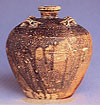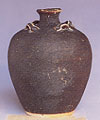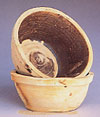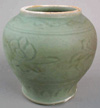 |
| Turiang |
28 Oct 2001
|
|||
| Last modified: 28 Oct 2001 |
The Chinese ceramics, categorised here in five groups, correspond to patterns of the Yuan dynasty (AD 1279-1368) or the early years of the succeeding Ming dynasty. The celadon came from the Longquan kilns in Zhejiang province; the other ninety per cent of the items came from Guangdong province.
There were great numbers of bowls, 15-17cm in diameter and 6-7cm high. Some have traces of a dark glaze; others appear unglazed. Their creamy clay and bevelled foot-ring design could easily allow confusion with Vietnamese products, but for reddish lumps of clay affixed in many cases to the interior. These were for stacking in the kiln, an unusual method. Similar lumps were found in the brown glazed storage jars and the green glazed dishes, both of which are definitely of Chinese origin, so it was concluded that the bowls are also Chinese. The rim of these bowls is either slightly everted, or pinched inwards for an 'S'-shaped side profile.
 These
are small flat plates, 12-13cm in diameter, made of a near-white clay with a
thin green glaze which varies from pale blue-ish green to grey-green to dark-green.
The body colour and texture also vary. The foot-rings are always well carved,
but vary in detail. The bases are roughly recessed and of small diameter. Some
have a broad unglazed stacking ring on the interior, some have spur marks, and
some have the same lumps of red stacking clay. The wide variation in all the
details is common for Guangdong ware, and suggests that there may have been
many different family-sized workshops, each supplying the same types of product
- a pattern of manufacturing still familiar in the region.
These
are small flat plates, 12-13cm in diameter, made of a near-white clay with a
thin green glaze which varies from pale blue-ish green to grey-green to dark-green.
The body colour and texture also vary. The foot-rings are always well carved,
but vary in detail. The bases are roughly recessed and of small diameter. Some
have a broad unglazed stacking ring on the interior, some have spur marks, and
some have the same lumps of red stacking clay. The wide variation in all the
details is common for Guangdong ware, and suggests that there may have been
many different family-sized workshops, each supplying the same types of product
- a pattern of manufacturing still familiar in the region.
 A
number of Chinese storage jars, 22-39cm high, are made of cream-coloured clay
with remaining traces of brown glaze. The necks are short, concave and well
finished with a rounded rim. Each jar has four small lug-handles, evenly placed
around the shoulder. One of these jars contained 52 covered boxes, described
below. However, most of the Chinese jars were found empty, while many of their
Thai counterparts were filled with cargo or provisions. One jar has a rim fragment
from another jar stuck to its base, the result of a firing accident.
A
number of Chinese storage jars, 22-39cm high, are made of cream-coloured clay
with remaining traces of brown glaze. The necks are short, concave and well
finished with a rounded rim. Each jar has four small lug-handles, evenly placed
around the shoulder. One of these jars contained 52 covered boxes, described
below. However, most of the Chinese jars were found empty, while many of their
Thai counterparts were filled with cargo or provisions. One jar has a rim fragment
from another jar stuck to its base, the result of a firing accident.

 The
same clay, lug-handles, and well-shaped base are seen in a number of bottles,
15-20cm high. These bottles are thinly potted and feature a tall neck with a
rounded rim. Glazes vary.
The
same clay, lug-handles, and well-shaped base are seen in a number of bottles,
15-20cm high. These bottles are thinly potted and feature a tall neck with a
rounded rim. Glazes vary.
 |
 |
| Cup (top) & bowl |
The Turiang carried an estimated 800 cups and bowls of blackish brown glazed ware. The 'cups', averaging 9cm in diameter, are thinly-potted with rounded sides and a pronounced recess below the rim. The glaze is almost matte, free from blots and stops short of the base. A high well-made foot-ring with a concave base, together with the clay, indicate Chinese manufacturing. The 'bowls' are similar in form and size - slightly larger, averaging 10cm in diameter. These are S-sided with a straight rim. The glaze is sometimes uneven and lumpy because of blistering, leaving the surface with lighter coloured patches, and slightly glossier than the first type. The clay is coarser than the first type, and the foot-ring surprisingly roughly finished.
![]() Some
larger bowls, 14.5-16.5cm in diameter and 6-7cm high, were distinguished by
the unusual cut of the base, with a slanted cut reversing to leave a lower centre.
It is no longer possible to tell whether these bowls were originally glazed.
Some had large spur marks on the interior.
Some
larger bowls, 14.5-16.5cm in diameter and 6-7cm high, were distinguished by
the unusual cut of the base, with a slanted cut reversing to leave a lower centre.
It is no longer possible to tell whether these bowls were originally glazed.
Some had large spur marks on the interior.
 Two
thickly-potted basins with a thick straight rim, 20-23cm in diameter and 8.5-10.5cm
high, are also believed to be of Chinese origin because of their clay and glaze,
although similar forms have been noticed among Vietnamese wares. The interiors
are brown-glazed, but the exteriors left unattended. The clay is rather coarse.
One basin had patches of the red stacking clay stuck to the interior.
Two
thickly-potted basins with a thick straight rim, 20-23cm in diameter and 8.5-10.5cm
high, are also believed to be of Chinese origin because of their clay and glaze,
although similar forms have been noticed among Vietnamese wares. The interiors
are brown-glazed, but the exteriors left unattended. The clay is rather coarse.
One basin had patches of the red stacking clay stuck to the interior.
Fifty-two small covered boxes were found inside a broken Chinese storage jar. These boxes were complete with lids. They have a finely potted rim and recess between the two parts, and a blackish brown glaze.
 |
 |
Just two of the lids were fixed to the body by small spots of glaze, a practical feature found with similar boxes from other shipwrecks, including the Longquan and the Xuande. (A gentle knock is sufficient to separate the two parts.) It took the investigators a very long time to match up all the others, as all are slightly different in diameter - so, contrary to common belief, the rims are not moulded. Two of the lids have an 'X' mark, drawn in a black glaze contrasting with a brownish background. The glaze, clay, foot-ring and concave base are very similar to those of the cup-bowls, and the boxes almost certainly originate from China. The boxes are of three diameters, 5.5, 7.5 and 8cm. They have an oval profile; some proportionately higher than others.
Eight jarlets were recovered, each with two ring handles and a dark brown glaze and 5-6.5cm high.
 |
 |
 |
| Photo (24K) |

 Two
smaller guan jars were found, 14-15cm high, with four lids. The lids are flatter
than for the large guan; one is decorated.
Two
smaller guan jars were found, 14-15cm high, with four lids. The lids are flatter
than for the large guan; one is decorated.
 Also
interesting are a few very large dishes, up to 45cm diameter. These have impressed
and incised decorations of varying degree, in the centre, on the cavetto (the
curving surface of the interior sides), and sometimes also on the exterior.
One of these dishes has a weak radial fluting on the cavetto. The rims are sometimes
plain, and sometimes beautifully foliated. The glaze is opaque, thick, and covers
the foot except for an unglazed
stacking ring.
Also
interesting are a few very large dishes, up to 45cm diameter. These have impressed
and incised decorations of varying degree, in the centre, on the cavetto (the
curving surface of the interior sides), and sometimes also on the exterior.
One of these dishes has a weak radial fluting on the cavetto. The rims are sometimes
plain, and sometimes beautifully foliated. The glaze is opaque, thick, and covers
the foot except for an unglazed
stacking ring.
A number of other Longquan celadon dishes are between 26 and 28 cm in diameter. These often display a stamped floral motif in the centre, under the glaze, and frequently feature a foliated rim with a high vertical edge. Some of these pieces have incised radial striations on the cavetto, made by a five or six pronged tool. The glaze is similar to the large dishes. The clay varies from reddish-brown to grey.
 |
 |
As noted in 'ceramic issues', many of the Longquan celadon dishes had scars or remains of tubular supports.
 |
| Turiang overview | Maritime Asia homepage | Next: other ceramics on board |